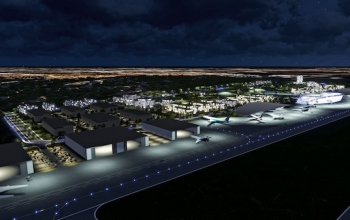Knowing that the port to space is no longer exclusively preserved to astronauts is one thing. Being on an actual flight is another. Not even for the need of a big bag of money, neither for the preparation it takes. But just for the simple fact that you need a place to actually board your rocket.
By Marcella Das
Last year Richard Branson’s company Virgin Galactic has sold the first tickets for non-astronauts to go into space. This is seen as the first step of the space flight market opening its doors for basically anybody who wants to invest in this very unique experience. In the near future the actual flight of these space tourists will take place. Waiting for the official permission of the Federal Aviation Administration (FAA) is the only thing that is still in the way. But Virgin Galactic expects to get the FAA-license soon.
Tourism
Since the space flight market is expected to experience a big boom, a whole new sector around space ports is emerging too. Thus far Branson’s rocket SpaceShipTwo has just been launched for test flights, making use of Mojave Air and Space Port in California and Spaceport America in New Mexico. These locations are one of the few available and usable space ports nowadays. However, if the first tourism flights are going to be an actual fact a big demand for more space ports is expected to arise very soon. And there is more to it than at first appears.
First of all the location needs to be suitable and a lot of factors seem to be involved. Atmospheric circumstances for instance seem to influence the visual experience, the distance to the equator influences the way you deal with gravity and of course it takes a lot of literal space, money and investments to build a suitable space port. Besides these geographical matters, also juridical and political interests play a big role. Think of regulations around environment, safety and noise.
Arm regulations
An illustrative example of the complexity is the fact that Chinese people are unable to book a space flight via Virgin Galactic. Since the space system of this company is based on an U.S. export control regime around arm regulations all would-be space fliers with a Chinese passport are denied access.
Another example is the proposed Spaceport Curaçao where - if it’s up to them - Space Expedition Corporation (SXC) will offer tourism space flights as soon as possible. SXC considers Hato International Airport of Curaçao a perfect location given all its numerous benefits: high tech infrastructure, suitable weather circumstances, close to the equator, a long runway, and the island being a very popular holiday destination. The space agency may be more than ready to go, the government of Curaçao is nowhere near as enthusiastic. Concerns about air pollution and excessive noise make them question the whole thing. Therefore SXC - that launched its first plans in 2005 – is still waiting for permission but if the difficulties persist they will consider another location in the Caribbean.
World War II
Not only in Curaçao are plans for proposed spaceports being made. Also several places in the U.S. or Kiruna in Sweden and Abu Dhabi are taken into account as future stations to hop on your rocket. Most of the plans in the tourism space flight are about building brand new gateways but space agency Space X is in negotiations with NASA to use the historic Launch Complex 39a at Kennedy Space Center in Florida.
Overall, there’s a lot going on around space ports and it’s not quite clear yet where it’s headed. What we do know and what may be interesting for your information is where it all started. The birthplace of modern rocket science is Peenemünde in Germany, where during World War II the first rockets were being launched. These V-2 rockets were the progenitors of all modern rockets. The first spaceport in the world that launched a manned space flight is the Baikonur Cosmodrome in Kazakhstan on April 12, 1961.
No matter how many people in the future may follow, cosmonaut Yuri Gagarin from the Soviet Union will always be the first person to have ever boarded a rocket into space.
Credit: picture from Astro Watch
